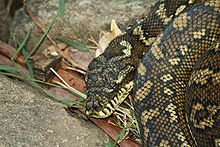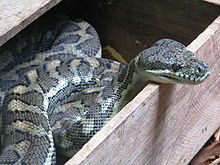- Morelia spilota
-
Morelia spilota 
Scientific classification Kingdom: Animalia Phylum: Chordata Subphylum: Vertebrata Class: Reptilia Order: Squamata Suborder: Serpentes Family: Pythonidae Genus: Morelia Species: M. spilota Binomial name Morelia spilota
(Lacépède, 1804)Morelia spilota is a large snake of the Pythonidae family found in Australia, Indonesia and New Guinea. There are 6 subspecies listed by ITIS, commonly referred to as Carpet and Diamond pythons.[1][2][3]
Contents
Description
A large python in the Morelia genus, reaching between 2 to 4 metres in length and weighing up to 15 kg. M. s. mcdowelli is the largest form, regularly attaining lengths of 2.7–3 m (9–10 feet).[4] M. s. variegata is the smallest, averaging of 120–180 cm (4-6) feet in length. The average adult length is roughly 2 m (6.5 ft). However, one 3-year-old captive male M. s. mcdowelli, measured in Ireland, was found to exceed 396 cm (13 ft). Males are typically smaller than females, in some regions females are up to four times heavier.[4] The head is triangular with a conspicuous row of thermoreceptive labial pits.
The colouring of Morelia spilota spilota is highly variable, olive to black with white or cream and gold markings. The patterning may be roughly diamond shaped or have intricate markings made up of light and dark bands on a background of gray or a version of brown.
The species are oviparous, with females laying 10-50 eggs at a time. Afterwards, females coil around the eggs to protect them and keep them warm through using muscular contractions to generate heat. This type of maternal care, which is typical for pythons, ceases once the hatchlings have emerged.
Behaviour
Described as semi-arboreal, they are largely nocturnal, climbing trees and shrubs as well as crossing open areas such as rock faces, forest floors and even roads. However, basking behaviour is commonly observed.
The diet consists mainly of small mammals, bats, birds and lizards. Morelia spilota kills their prey by constricting it until it suffocates. They are often the largest predator in their ecological community.
Geographic range
The species is found throughout mainland Australia, with the exception of the arid center and the western regions. It is widely distributed throughout the forest regions of Southwest Australia.[5] It is also found in Indonesia (southern Western New Guinea in Merauke Regency), Papua New Guinea (southern Western Province, the Port Moresby area of Central Province and on Yule Island) and ). The type locality given is "Nouvelle-Hollande" [Australia].[6]
Habitat
Occurs in a wide variety of habitats, from the rainforests of northeastern Queensland (M. s. cheynei) through the River Red Gum/Riverbox woodlands of the Murray and Darling Rivers (M. s. metcalfei), to the arid, treeless islands of the Nuyts Archipelago off the South Australian west coast (M. s. imbricata). Often found near human habitation where they perform a useful service by eating rats and other vermin. M. s. spilota is even know to occur in areas that receive snowfall. Morelia spilota are tree snakes, they do not completely rely on trees, however, and are capable of moving around elsewhere. Carpet pythons are also found in temperate grasslands with hot and dry weather.
Conservation
The nominate subspecies, Morelia spilota spilota, is listed as threatened with extinction in Victoria.[7] The subspecies M. spilota imbricata is regarded as near threatened in Western Australia, due to loss of habitat.[5]
Captivity
This species is a popular pet among enthusiasts. Some forms can be more irascible than others, such as M. s. mcdowelli and M. s. variegata. Forms that tend to be more even tempered include M. s. spilota and M. s. metcalfei. However this is not a hard rule. Although they can grow to a reasonable size (2-3.5 m) and can be nippy as hatchlings, most will grow into docile adults. However, care must be taken when feeding, as these snakes have a strong feeding response; behaviour that can be mistaken for aggression. Captive specimens are normally fed live or frozen rats. They may have a lifespan of 15 to 20 years.
The care requirements can be generalised for all subspecies.[8] The subspecies Morela spilota spilota, the cold weather Diamond python, has some separate requirements and habits.[9]
Subspecies
The geographic distribution and common names can summarised as follows:[1][10]
Subspecies[1] Taxon author[1] Common name Geographic range M. s. cheynei Wells & Wellington, 1984 Jungle carpet python Australia in northeastern Queensland. M. s. imbricata (Smith, 1981) Southern Carpet python Across Southwest Australia to the Eyre Peninsula in South Australia. M. s. mcdowelli Wells & Wellington, 1984 Coastal carpet python Australia in eastern Queensland and northeastern New South Wales. M. s. metcalfei Wells & Wellington, 1984 Inland carpet python Australia in the Murray-Darling Basin of Queensland, New South Wales, Victoria and South Australia. M. s. spilota (Lacépède, 1804) Diamond python Australia in eastern New South Wales and the extreme east of Victoria. M. s. variegata J.E.Gray, 1842 Carpet python New Guinea (Western New Guinea and Papua New Guinea) and Australia in northwestern Western Australia and in the northern portion of the Northern Territory. Naming and taxonomy
The first description of Morelia spilota was by Lacepede (1804), who placed it in the genus Coluber as Coluber spilotus. The species has since been described by various authors as containing a number of subspecies and hybrids, these have also been known by various informal names.[3][11] The attempted arrangement of taxa in this, and other, Australasian Pythonidae has produced numerous synonyms. The discrete and roaming habits of this species have produced a low number of recorded specimens, giving inadequate sample numbers to support descriptions of a taxon's morphology.[7] This is the case with proposed names which are sometimes cited, such as the Papuan Morelia spilota harrisoni (Hoser),[12] despite being unaccepted or invalid.[13] Common names are regional variants of Carpet and Diamond Python, or Snake.[14][15] The database ITIS lists six subspecies with valid names,[1] these may be summarised as follows:
- Morelia Gray, 1842 (Pythonidae)
- Morelia amethistina (Schneider, 1801)
- Morelia boeleni (Brongersma, 1953)
- Morelia bredli (Gow, 1981)
- Morelia carinata (Smith, 1981)
- Morelia oenpelliensis (Gow, 1977)
- Morelia spilota (Lacépède, 1804)
- Morelia viridis (Schlegel, 1872)
Early descriptions placed this species in other genera, Coluber or Python, and Morelia argus is a synonym for this species. The following is an incomplete list of synonyms:[6][11]
- [Coluber] Arges - Linnaeus, 1758
- [Coluber] Argus - Linnaeus, 1766
- Coluber spilotus - Lacépède, 1804
- [Python] punctatus - Merrem, 1820
- [Coluber (Natrix)] Argus - Merrem, 1820
- [Vipera (Echidna)] Spilotes - Merrem, 1820
- Python Peronii - Wagler, 1828
- Python spilotes - Gray In G. Grey, 1841
- Morelia punctata - Gray, 1842
- Morelia argus - A.M.C. Duméril & Bibron, 1844
- Morelia spilotes - Gray, 1849
- M[orelia]. argus var. fasciolata - Jan In Jan & Sordelli, 1864
- Python spilotes - Boulenger, 1893
- [Python spilotes spilotes] - Werner, 1909
- Python spilotes macrospila - Werner, 1909
- Morelia argus - Loveridge, 1934
- Morelia argus - Stull, 1935
- Morelia spilotes spilotes - Worrell, 1961
- Morelia argus argus - Stimson, 1969
- Python spilotes - McDowell, 1975
- [Python spilotus spilotus] - L.A. Smith, 1891
- Morelia spilota - Cogger, Cameron & Cogger, 1983
- Morelia spilota - Underwood & Stimson, 1990
- Morelia spilota spilota - Barker & Barker, 1994
See also
- List of pythonid species and subspecies
- Pythonidae by common name
- Pythonidae by taxonomic synonyms
References
- ^ a b c d e ."Morelia spilota". Integrated Taxonomic Information System. http://www.itis.gov/servlet/SingleRpt/SingleRpt?search_topic=TSN&search_value=634780. Retrieved 17 September 2007.
- ^ Browne-Cooper, Robert; Brian Bush, Brad Maryan, David Robinson (2007). Reptiles and Frogs in the Bush: Southwestern Australia. University of Western Australia Press. p. 99. ISBN 9778 1 920694 74 6.
- ^ a b Cogger, Harold G.. Reptiles and Amphibians of Australia.
- ^ a b "Carpet Python Morelia spilota (Lacépède, 1804)". FaunaBase. Department of Environment and Conservation. http://www.dec.wa.gov.au/component/option,com_docman/Itemid,/gid,138/task,doc_download/. Retrieved 2008-10-20.
- ^ a b Pearson, D.; Shine, R. ; Williams, A. (May 2005). "Spatial ecology of a threatened python (Morelia spilota imbricata) and the effects of anthropogenic habitat change". Austral Ecology 30 (3): 261–274(14). doi:10.1111/j.1442-9993.2005.01462.x.
- ^ a b McDiarmid RW, Campbell JA, Touré T. 1999. Snake Species of the World: A Taxonomic and Geographic Reference, vol. 1. Herpetologists' League. 511 pp. ISBN 1-893777-00-6 (series). ISBN 1-893777-01-4 (volume).
- ^ a b "Action statement: Diamond Python Morelia spilota spilota ". Flora and Fauna Guarantee Act 1988 No. 104. Department of Sustainability and Environment. http://www.dse.vic.gov.au/CA256F310024B628/0/E9252A5B29C51751CA2570ED0001218E/$File/104+Diamond+Python+2000.pdf. Retrieved 2008-10-20.
- ^ "Carpet pythons (Morelia spilotes sp.)". Care Sheet. Monaro Amphibian & Reptile Keepers (MARK). http://www.mark.org.au/pages/cs_carpetpython.htm. Retrieved 2008-10-20.
- ^ "Diamond Pythons (Morelia spilota spilota)". Care Sheet. Monaro Amphibian & Reptile Keepers (MARK). http://www.mark.org.au/pages/cs_diamondpython.htm. Retrieved 2008-10-20.
- ^ Citing? McDiarmid, Roy W., Snake Species of the World: A Taxonomic and Geographic Reference, vol. 1 Washington
- ^ a b Morelia spilota at the Reptarium.cz Reptile Database. Accessed 17 September 2007.
- ^ Hoser, R. (2000a) A revision of the Australasian pythons. Ophidia Review 1(1): 7-27.
- ^ Wüster, W., B. Bush, J.S. Keogh, M. O'Shea & R. Shine (2001). "Taxonomic contributions in the "amateur" literature: comments on recent descriptions of new genera and species by Raymond Hoser.". Litteratura Serpentium 21: 67-79, 86-91. http://biology.bangor.ac.uk/~bss166/FWit/LittSerp.pdf.
- ^ Mehrtens JM. 1987. Living Snakes of the World in Color. New York: Sterling Publishers. 480 pp. ISBN 0-8069-6460-X.
- ^ Ditmars RL. 1933. Reptiles of the World. Revised Edition. The MacMillan Company. 329 pp. 89 plates.
Further reading
- Mattison, C. 1999. Snake. DK Publishing. ISBN 0-7894-4660-X.
External links
 Data related to Morelia spilota at Wikispecies
Data related to Morelia spilota at Wikispecies  Media related to Morelia spilota at Wikimedia CommonsCategories:
Media related to Morelia spilota at Wikimedia CommonsCategories:- Reptiles of Australia
- Reptiles of New Guinea
- Morelia
- Morelia Gray, 1842 (Pythonidae)
Wikimedia Foundation. 2010.



